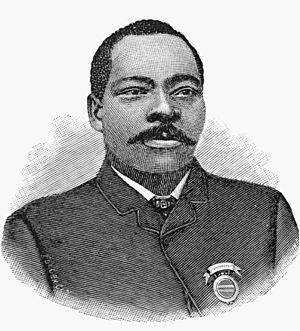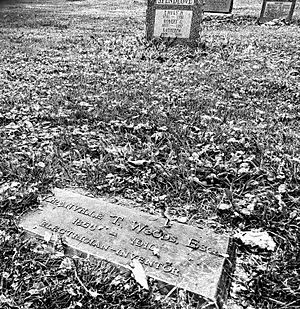Granville Woods facts for kids
Quick facts for kids
Granville Tailer Woods
|
|
|---|---|

Illustration of Granville T. Woods
|
|
| Born |
Granville Tailer Woods
April 23, 1856 |
| Died | January 30, 1910 (aged 53) |
| Cause of death | Cerebral hemorrhage |
| Nationality | American |
| Occupation | Inventor |
| Home town | Columbus, Ohio |
Granville Tailer Woods (born April 23, 1856 – died January 30, 1910) was a brilliant American inventor. He held more than 60 patents in the United States. Granville Woods was the first African American mechanical and electrical engineer after the American Civil War. He taught himself much of what he knew. Most of his inventions helped improve trains and streetcars.
One of his most famous inventions was the Synchronous Multiplex Railway Telegraph. This device used existing electricity from telegraph lines. It allowed train stations to send messages to moving trains. His work made public transportation safer and better across the United States.
Contents
Early Life and Education
Granville T. Woods was born in Columbus, Ohio. His parents were Martha J. Brown and Cyrus Woods. He also had a brother named Lyates. His mother had some Native American heritage. His father was African American.
Granville went to school in Columbus until he was 10 years old. He had to leave school to work because his family was poor. He became an apprentice in a machine shop. There, he learned how to be a machinist and a blacksmith. Some people at the time said he also studied electrical and mechanical engineering in college for two years. However, we don't know much about where he might have studied.
Granville Woods' Career
In 1872, Woods started working as a fireman on a railroad in Missouri. He later became a train engineer. In 1874, he moved to Springfield, Illinois. There, he worked at a rolling mill. He continued to study engineering on his own.
In 1878, he got a job on a steamship called the "Ironsides." Within two years, he became its Chief Engineer. After that, he returned to Ohio. He worked as an engineer for another railroad company. In 1880, he moved to Cincinnati, Ohio. There, he started his own business as an electrical engineer and inventor. After getting a patent for his multiplex telegraph, he renamed his company the Woods Electric Co. In 1892, he moved his research work to New York City. His brother, Lyates Woods, who was also an inventor, joined him there.
Granville T. Woods was known as a smart and well-spoken man. He dressed very carefully and stylishly, often in black. Sometimes, he would pretend to be an immigrant from Australia. He thought people might respect him more if they believed he was from a foreign country, rather than being an African American. Black newspapers of his time were very proud of his achievements. They called him "the greatest of Negro inventors."
Amazing Inventions
Granville T. Woods invented many things. He even patented a way to build tunnels for electric railroads. Some people called him the "Black Edison." During his life, he received more than 50 patents. His inventions included an automatic brake and an egg incubator. He also made improvements to other technologies. These included the safety circuit, the telegraph, the telephone, and the phonograph.
Early Patents and Telegraphony
In 1884, Woods received his first patent for a steam boiler furnace. In 1885, he patented a device that combined a telephone and a telegraph. He called this invention "telegraphony." It allowed a telegraph station to send both voice and Morse code messages over a single wire. He sold the rights to this invention to the American Bell Telephone Company.
The Synchronous Multiplex Railway Telegraph
In 1887, Woods patented the Synchronous Multiplex Railway Telegraph. This invention allowed trains to communicate with stations while moving. It worked by creating a magnetic field around a coiled wire under the train. Woods had to defend his patent in court against Thomas Edison. Edison claimed he had invented a similar device first. Woods won both times, proving his invention was original. After his second loss, Thomas Edison offered Woods a job at his company. However, Granville Woods politely turned him down.
Electric Railway Systems
In 1888, Woods created a system for overhead electric lines for railroads. This system was similar to one by Charles van Depoele. Van Depoele had already installed his electric railway system in many U.S. cities.
After a huge snowstorm in 1888, New York City decided all overhead wires should be buried underground. This was especially important for the rail system. Woods' patent improved existing underground electric systems. His system used special wire brushes to connect with metallic parts. This allowed trains to get power without exposed wires. Once a train passed, the wires were no longer live, making it safer. This system was tested successfully in 1892 in Coney Island. In 1901, he sold this important invention to General Electric.
Safety Dimmer and Air Brake
In 1896, Woods invented a system to control electrical lights in theaters. This was called the "safety dimmer." It was efficient and saved 40% of electricity.
Woods is also sometimes given credit for inventing the air brake for trains in 1904. However, George Westinghouse had patented the air brake almost 40 years earlier. Woods' contribution was an important improvement to Westinghouse's invention.
Death and Legacy
Granville T. Woods passed away from a cerebral hemorrhage in New York City on January 30, 1910. He had sold many of his inventions to big companies like Westinghouse and General Electric. For many years, his grave did not have a headstone. But in 1975, a historian named M.A. Harris helped raise money. She convinced some companies that used Woods' inventions to donate funds for a headstone. It was placed at St. Michael's Cemetery in Elmhurst, Queens.
Granville T. Woods left behind a great legacy:
- Baltimore City Community College created the Granville T. Woods scholarship in his honor.
- In 2004, the New York City Transit Authority held an exhibition about Woods. They also made four million MetroCards to celebrate his work on the third rail system.
- In 2006, Woods was added to the National Inventors Hall of Fame.
- In April 2008, a street corner in Coney Island was named Granville T. Woods Way.
See also
 In Spanish: Granville T. Woods para niños
In Spanish: Granville T. Woods para niños



